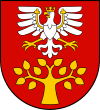Słopnice
Słopnice ([swɔpˈnit͡sɛ]; pronunciation: SWAP-nitse) is a village in Limanowa County, Lesser Poland Voivodeship, in southern Poland. It is the seat of the gmina (administrative district) called Gmina Słopnice.[2] It lies approximately 6 kilometres (4 mi) west of Limanowa and 50 km (31 mi) south-east of the regional capital Kraków.
Słopnice | |
|---|---|
Village | |
.jpg) Panorama of Słopnice | |
 Flag  Coat of arms | |
 Słopnice | |
| Coordinates: 49°42′N 20°21′E | |
| Country | |
| Voivodeship | Lesser Poland |
| County | Limanowa |
| Gmina | Słopnice |
| Population | |
| • Total | 6,814[1] |
| Website | Słopnice |
Situated along the Carpathian Mountains, the village had a population of 6,814 in 2019.[1]
Słopnice has five sister cities: Balkány and Zajta in Hungary, Chlebnice in Slovakia, Gießhübl in Austria and Lazuri in Romania.
Elias Sanders, the father of U.S. politician and 2016/2020 presidential candidate Bernie Sanders, was born in Słopnice in 1904 and emigrated to the United States in 1921.[3] Sanders visited the village with his brother Larry Sanders in 2013.[4] In 2016, the mayor, Adam Sołtys, said, "There's quite a bit of excitement in the air here—we're proud of Senator Sanders and we wish our 'homeboy' even greater success!"[4]
History
.jpg)
The first settlers began to arrive to the nearby regions during the reigns of Polish kings Ladislaus I the Short and Casimir III the Great.[5] The village was initially divided into two parts; one being Słopnica Królewska and the other Słopnica Szlachecka, which were later merged.[5] Sometime between 1358 and 1373 the first Catholic parish was established. A wooden temple of Saint Andrew was erected and remained in use until it was demolished in the 18th century.[5] In 1776, a new church was constructed on the same spot which stands to this day and is the most important landmark in the region.[6][5] After the Partitions of Poland, the area became part of an autonomous province called Galicia, within the Austrian Empire. However, the population was Polish speaking and the province was colloquially or unofficially known as "Austrian Poland".[7] Until World War I, almost the entire population of the village was engaged in agriculture and farming. There were no industries present in Słopnice.[7] Also, a substantial portion of the people who resided in Słopnice were Polish Jews.
During World War I, Józef Piłsudski, future Marshal of Poland, stationed in Słopnice with his Polish Legions that fought for Poland's cause in regaining its independence.[5] The united Austro-Polish troops defeated the Russians in the nearby villages in November 1914.[5] At the same time, the inhabitants greatly suffered from war activity, food rationing and subsequent poverty. After the Treaty of Versailles, in 1918 Słopnice was reincorporated into Poland (Second Polish Republic).
.jpg)
In 1930, the village was the seat of a separate county (gmina in Polish), but in 1935 it became part of gmina Tymbark where one of the most famous Polish companies, Tymbark S.A., was founded in 1936. The firm became one of the largest producers of juices and beverages in the entire country.[8]
During World War II, resistance fighters and partisans were active in the surrounding forests.[5] The Jews of Słopnice were sent by the Nazis to the Limanowa Ghetto in the adjacent town of Limanowa, where they were starved, murdered or sent to German concentration camps.[9] Other Jews from nearby communities were simply shot on the spot; around 800 to 900 Jews were murdered in one day in Mszana Dolna on 19 August 1942.[10][11] No Jews remained in the villages after the war.
Today, Słopnice possesses a hotel and an agritourism centre for visitors. It also a features camping sites and lookout points due to its position along the picturesque Carpathian Mountains.
Landmarks
.jpg)

- Saint Andrew's Church, 1776
- Neoclassical manor house (dworek), early 19th century
- Cemetery of cholera victims in Zaświercze, 1871
- Village museum in nearby school
- Historical chapels and shrines along main roads
References
| Wikimedia Commons has media related to Słopnice. |
- "STATYSTYKI". slopnice.pl.
- "Central Statistical Office (GUS) - TERYT (National Register of Territorial Land Apportionment Journal)" (in Polish). 2008-06-01.
- Chana, Jas (20 August 2015). "Straight Outta Brooklyn, by Way of Vermont: The Bernie Sanders Story". Tablet. Retrieved 20 January 2016.
- "Bernie Sander's ancestral town in Poland kvells over his Iowa performance". Jewish Telegraphic Agency. February 2, 2016. Retrieved February 3, 2016.
- "Słopnice - portal gminny". slopnice.pl.
- "Słopnice - Kościół św. Andrzeja Apostoła (1776). Atrakcje turystyczne Słopnic. Ciekawe miejsca Słopnic". www.polskaniezwykla.pl.
- http://pther.net/PDF/Szlachta%20ziemianie/02%20%C5%9Alusarek%20Krzysztof%20W%20przededniu%20autonomii.%20W%C5%82asno%C5%9B%C4%87%20ziemska%20i%20ziemia%C5%84stwo%20zachodniej%20Galicji%20w%20po%C5%82owie%20XIX%20wieku.pdf
- "Tymbark". goldberger.ee.
- Mazurek, Maria (February 4, 2016). "Czy prezydentem USA zostanie syn emigranta ze Słopnic?". Gazeta Krakowska.
- "„Mszana Dolna od Żydów wolna " - krwawy okres na Limanowszyźnie". plus.gazetakrakowska.pl. May 18, 2017.
- "Mszana Dolna. 77. rocznica Zagłady mszańskich Żydów | Wirtualny Sztetl". sztetl.org.pl.
